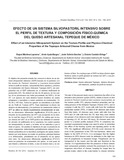| dc.rights.license | http://creativecommons.org/licenses/by-nc-sa/3.0/ve/ | |
| dc.contributor.author | Martínez Loperena, Raquel | |
| dc.contributor.author | Ayala Burgos, Armín Javier | |
| dc.contributor.author | Solorio Sánchez, Javier | |
| dc.contributor.author | Castelán Ortega, Octavio | |
| dc.date.accessioned | 2015-04-22T14:35:31Z | |
| dc.date.available | 2015-04-22T14:35:31Z | |
| dc.date.issued | 2015-04 | |
| dc.identifier.issn | 0798-2259 | |
| dc.identifier.uri | http://www.saber.ula.ve/handle/123456789/40200 | |
| dc.description.abstract | El objetivo del presente estudio fue conocer el efecto de un sistema
silvopastoril intensivo (SSPi) basado en el pastoreo a libre
acceso de Panicum maximum y Leucaena leucocephala
sobre el perfil de textura, composición físico química y proceso
de maduración del Queso Artesanal Tepeque (QAT), en comparación
con el QAT elaborado en el sistema tradicional de
producción (ST). Se elaboró un lote de 48 quesos, de los cuales
24 se procesaron con leche proveniente del SSPi y 24 del
ST. Los quesos de cada sistema fueron divididos en cuatro
subgrupos y sometidos a cuatro periodos de maduración: 10;
45; 80 y 165 días. Todos los quesos se sometieron a un Análisis
de Perfil de Textura (APT). Para determinar el efecto del
sistema de alimentación y los periodos de maduración sobre el
APT se utilizó un diseño experimental completamente al azar.
No se observaron diferencias significativas (P>0,05) para la
mayoría de los parámetros del APT con excepción de la dureza,
la cual fue mayor (P<0,01) en SSPi. Se estima que la mayor
dureza del QAT en el SSPi podría ser atribuida al contenido
elevado de polifenoles en la Leucaena, los cuales pueden
ser transportados al suero y la leche de los animales y por lo
tanto al queso. Se plantea la hipótesis de que la presencia de
estos compuestos antioxidantes probablemente aminoró la actividad
proteolítica de la microflora endógena del queso manteniendo
por más tiempo su matriz de proteína, principal barrera
a la deformación, permitiendo así el desarrollo de un queso
más duro. Se observaron diferencias significativas (P<0,01)
entre los periodos de maduración del queso, el cual pasa de
uno blando y adhesivo al inicio, a uno de textura dura y no adhesivo
al final. Se concluye que el SSPi no tiene efectos significativos
sobre el perfil general de textura del QAT y sus propiedades
físico-químicas. | es_VE |
| dc.rights | info:eu-repo/semantics/openAccess | |
| dc.subject | Queso artesanal tepeque | es_VE |
| dc.subject | Sistema silvopastoril intensivo | es_VE |
| dc.subject | Análisis de perfil de textura | es_VE |
| dc.title | Efecto de un sistema silvopastoril intensivo sobre el perfil de textura y composición físico-química del queso artesanal tepeque de México | es_VE |
| dc.title.alternative | Effect of an intensive silvopastoril system on the texture profile and physico-chemical properties of the tepeque artisanal cheese from Mexico | es_VE |
| dc.type | info:eu-repo/semantics/article | |
| dc.description.abstract1 | The aim of the present study was to determine the effect of an
intensive silvo-pastoral system (ISPS), which is based on free
access to Panicum maximum and Leucaena leucocephala, on
the texture profile (TP), physico-chemical properties and ripening
process of the Artisanal Tepeque Cheese (ATC), and to
compare it with the ATC made with milk from the traditional
production system (TPS). A batch of 48 cheeses was made,
from this batch, 24 cheeses were made with milk from the
ISPS and 24 with milk from the TS; then they were divided
into groups of six cheeses each and subjected to four periods
of ripening (10, 45, 80 and 165 days). All cheeses were subjected
to a texture profile analysis (TPA). A completely randomized
experimental design was used in order to determine
the effect of the feeding system and ripening period on the
TPA. No significant differences (P>0.05) were observed for
most of the parameters of the TPA but hardness, which was
higher in the ISPS (P<0.01). It is envisaged that the higher
hardness in ISPS cheese could be attributed to the high content
of polyphenols in leucaena forage. Polyphenols can be
transported to the serum and the milk and therefore to the
cheese. It is hypothesized that the presence of these antioxidant
compounds probably reduced the proteolysis by the endogenous
micro-flora of cheese, keeping for longer time its
protein matrix, which is the main barrier to cheese deforma-
tion. Thus, it is suggested that the action of polyphenols resulted
in a harder cheese. Significant differences (P<0,01)
were observed between ripening periods as the ATC passes
from a soft and sticky cheese to a hard and not sticky one. It is
concluded that the ISPS has no significant effects on the overall
TPA and its physico-chemical properties. | es_VE |
| dc.description.colacion | 153-158 | es_VE |
| dc.description.email | oaco2002@yahoo.com.mx | es_VE |
| dc.identifier.depositolegal | 199102ZU46 | |
| dc.publisher.pais | Venezuela | es_VE |
| dc.subject.Mots-cles | Texture profile analysis | es_VE |
| dc.subject.institucion | Universidad del Zulia (LUZ) | es_VE |
| dc.subject.institucion | Universidad de Los Andes (ULA) | es_VE |
| dc.subject.keywords | Tepeque artisanal cheese | es_VE |
| dc.subject.keywords | Intensive silvopastoral system | es_VE |
| dc.subject.publicacionelectronica | Revista Científica | |
| dc.subject.seccion | Revista Científica: | es_VE |
| dc.subject.thematiccategory | Medio Ambiente | es_VE |
| dc.subject.tipo | Revistas | es_VE |
| dc.type.media | Texto | es_VE |


